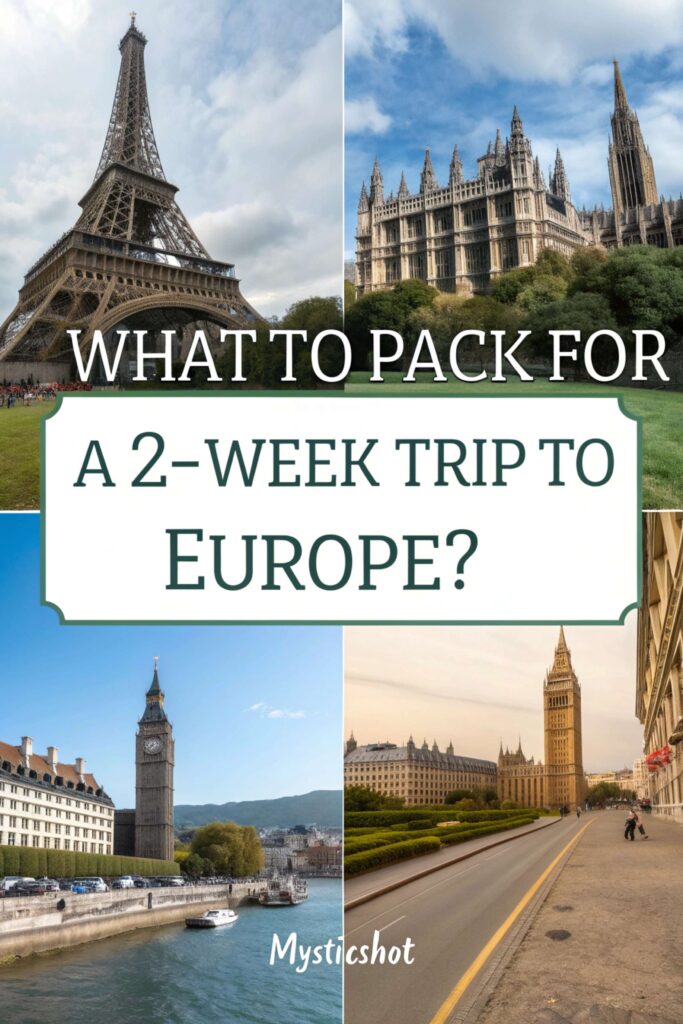Packing for a 2-week trip to Europe can feel like a balancing act—too much gear, and you’re dragging a heavy suitcase down narrow streets; too little, and you’re hunting for socks in Prague.
The question you might be asking.
What to Pack for a 2-Week Trip to Europe?
Table of Contents
No stress, though—this guide keeps things simple, conversational, and packed with practical tips.
Think of it as a friendly chat about what works for cobblestone walks, café lounging, and all the adventures in between.
Let’s dive into nailing that perfect packing list!

Why Packing Smart for Europe Matters
Europe’s got it all—bustling cities, quiet countryside, and weather that changes fast. One minute you’re snapping pics by the Eiffel Tower, the next you’re hiking in Austria.
The trick?
A bag that’s ready for anything without slowing you down.
Lugging an overstuffed suitcase up a hostel staircase in Barcelona sounds like a nightmare—keeping it light is the way to go.
Clothing Essentials for 2 Weeks in Europe
Clothes need to be versatile and easy to layer. Here’s a solid lineup:
- Tops: 5-6 pieces—t-shirts, a couple of blouses, maybe a sweater. Stick with colors that mix and match effortlessly.
- Bottoms: 2-3 pairs—jeans, chinos, or a skirt if it’s warm. Pick fabrics that resist wrinkles.
- Layers: A light jacket or cardigan. Europe’s weather can switch from sunny to rainy in a flash.
- Undies and Socks: Enough for a week, then wash. Add a couple of bras too.
- PJs: Something lightweight like a tee or comfy shorts.
- Scarf or Shawl: Handy as a plane blanket or a cover-up for fancy churches.
Not sure what fabrics hold up best? Check out REI’s guide for some pro tips on picking travel-friendly threads.
Skipping a jacket in Florence can leave you shivering—it’s a rookie move. Layers save the day, especially when the weather turns chilly, like in Amsterdam.
Skipping a jacket in Florence can leave you shivering—it’s a rookie move. Layers save the day, especially when the weather turns chilly, like in Amsterdam.
Footwear: Comfort Beats Style Every Time
Europe means walking—tons of it—over cobblestones and through museums. Shoes have to hold up. Here’s what works:
- Walking Shoes: Sneakers or sturdy flats. Break them in first to avoid blisters.
- Dressy Pair: Something for dinners or nights out—loafers or short boots do the trick.
- Sandals: Perfect for hot days or beachy spots if the weather calls for it.
Brand-new boots in Paris? That’s a recipe for sore feet. Stick with what’s already comfortable.
Toiletries: Keep It Compact and Simple
Toiletries can eat up space fast, so go small. Here’s the essentials:
- Basics: Toothpaste, shampoo, deodorant—travel-sized versions.
- Moisturizer: Planes dry out skin—don’t skip this one.
- Makeup: Mascara, lip balm, and a light cream keep it minimal.
- Sunscreen: Even in cooler months, the sun can surprise you.
- Meds: Whatever’s necessary, plus some pain relievers.
Pop everything in a small pouch—keeps things tidy during bumpy train rides.

Electronics: Stay Charged and Connected
Photos and navigation are non-negotiable. Here’s what to pack:
- Phone and Charger: Your all-in-one for pics, maps, and translations.
- Power Bank: Outlets aren’t always handy—this keeps the phone alive.
- Adapter: Europe’s plugs differ—grab a universal one.
- Camera (Optional): If the phone’s camera struggles, a compact one’s worth it.
Missing a perfect Venice shot because the battery died? A power bank prevents that headache.
Miscellaneous Must-Haves
These extras make the trip smoother:
- Water Bottle: Refillable—saves money and keeps hydration on lock.
- Umbrella: A tiny one—rain can sneak up anywhere.
- Money Belt: Stash cash and the passport safely—pickpockets target tourists.
- Packing Cubes: Keeps the bag organized and chaos-free.
- First-Aid Kit: Bandages, wipes—basic stuff to handle small emergencies.
Ever tried packing cubes? They might sound like a gimmick, but they keep everything neat and easy to find.
Packing for Europe’s Seasons
Weather varies wildly by season. Here’s a quick breakdown:
- Spring (March-May): Layers—sweater, light jacket, something waterproof.
- Summer (June-August): Light clothes, sunglasses, hat. Sunscreen’s a must.
- Fall (September-November): Layers again, scarf for cool evenings.
- Winter (December-February): Coat, gloves, warm gear. It can get frosty!
Getting caught in Amsterdam rain in July? Summer isn’t always sunny—check the forecast.

How to Pack Light for a 2-Week Trip
Less baggage equals more freedom. Here’s how to trim it down:
- Color Match: Neutrals—everything pairs up easily.
- Shoe Limit: Two pairs max—wear the bulky ones on the plane.
- Cubes: Compress clothes and keep them organized.
- Wear the Big Stuff: Travel in the jacket or boots to save space.
Packing three pairs of shoes might feel tempting, but it just adds weight. Two’s plenty—leaves room for souvenirs.
FAQs About Packing for Europe
How much luggage is enough?
A carry-on and a backpack or tote. Big bags struggle on cobblestone streets.
What if something’s forgotten?
No big deal—Europe has stores. Pick up what’s missing locally.
Backpack or suitcase?
Suitcase with wheels for cities, backpack for hostel-hopping.
Fancy outfits required?
Not really—one nice outfit for dinners covers it. Europe’s pretty casual.
Laundry on the road?
Most hotels or hostels offer it, or just rinse socks in the sink.

Wrapping Up the Europe Packing Plan
Packing for a 2-week Europe trip doesn’t have to be overwhelming. Focus on versatile clothes, comfy shoes, and a few key extras, and you’re golden.
Leave a little space for that quirky trinket or extra pastry—it’s worth it.
Want some eco-friendly spots to hit while you’re there? Peek at these 15 nature-lover destinations for some green travel ideas. With this plan, exploring Europe will feel effortless. Happy travels!
